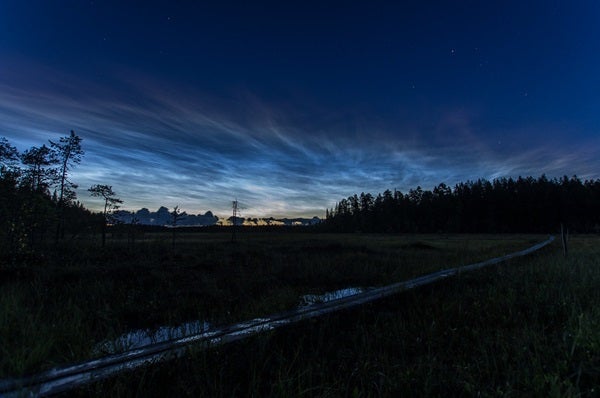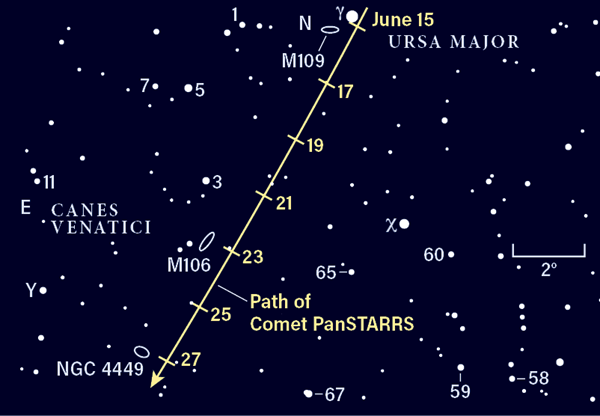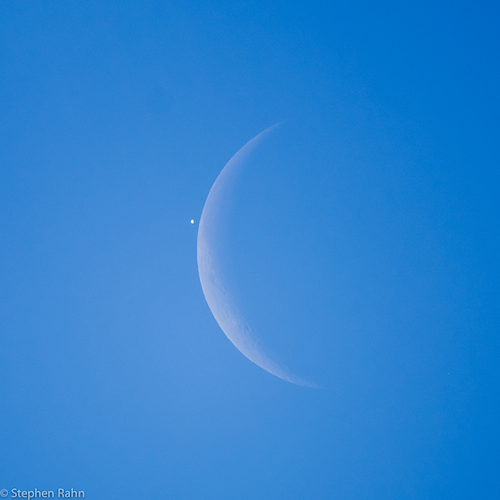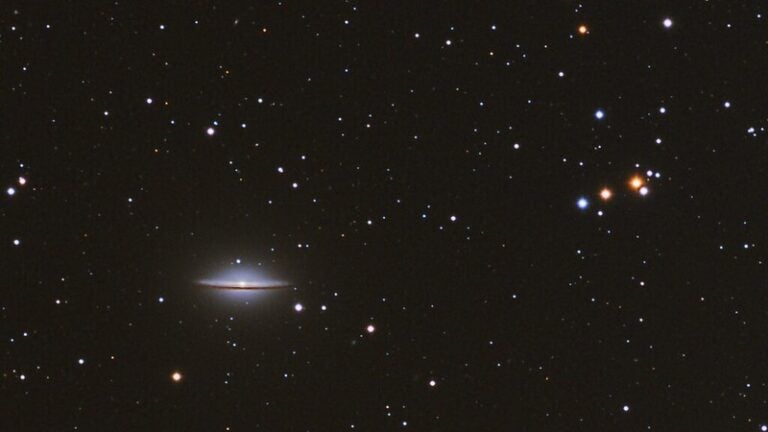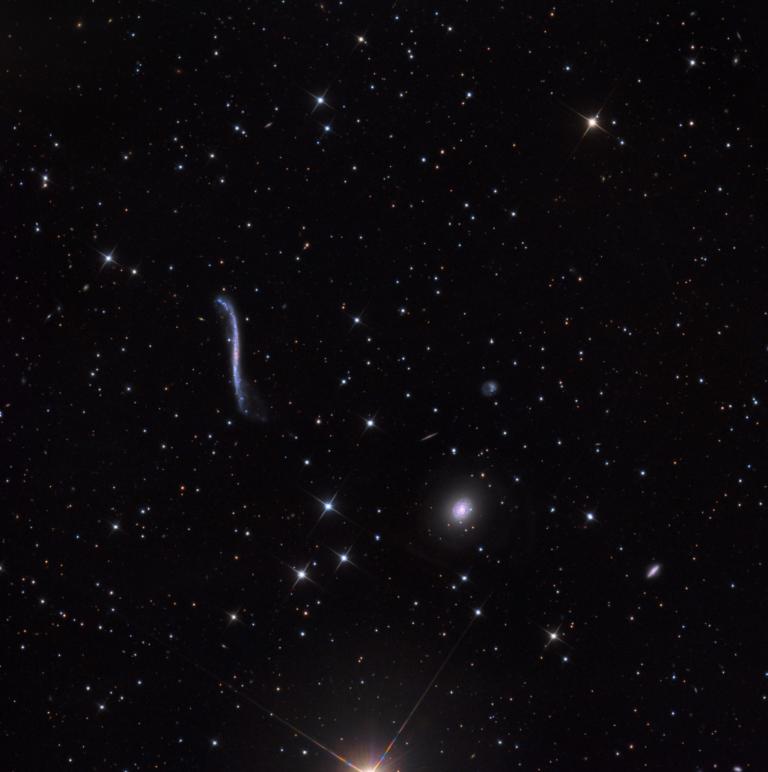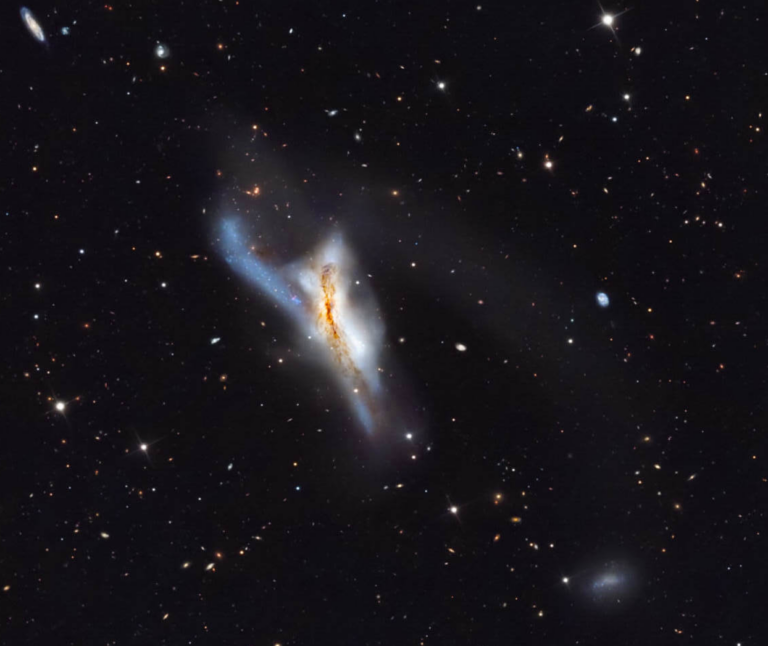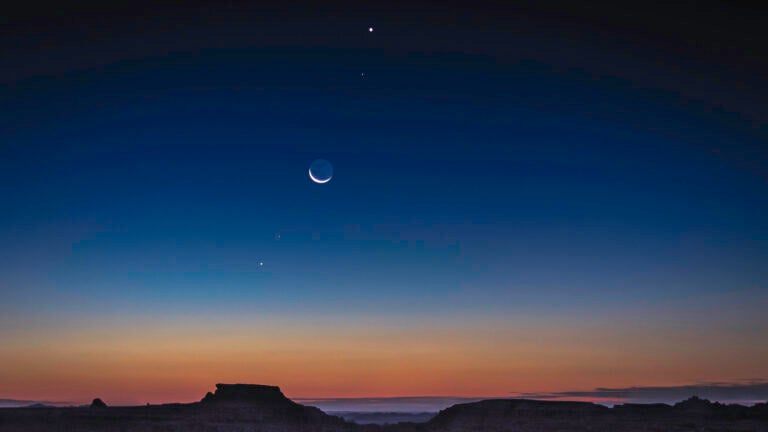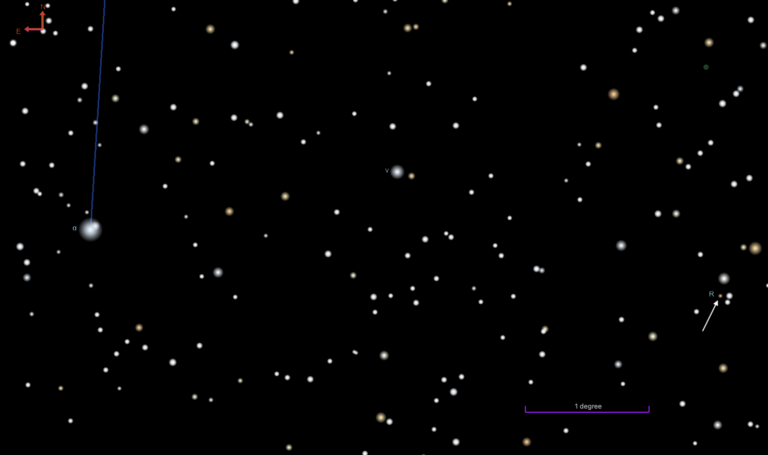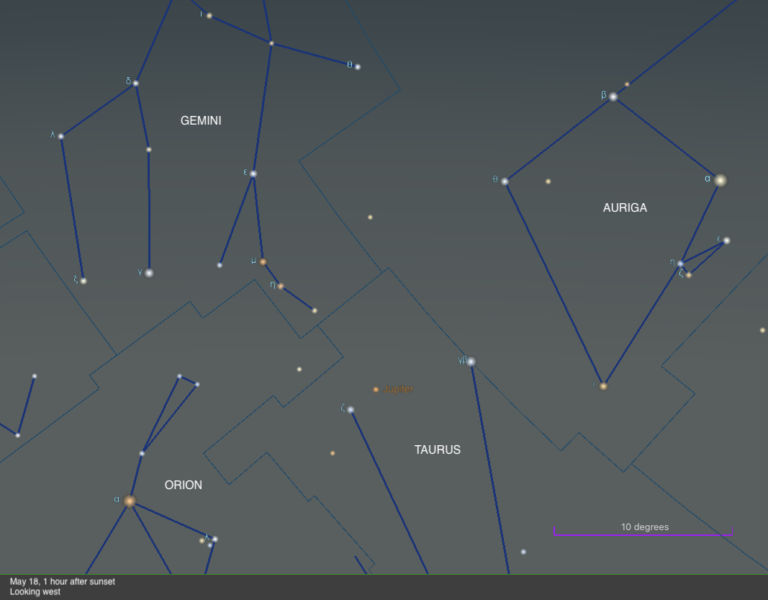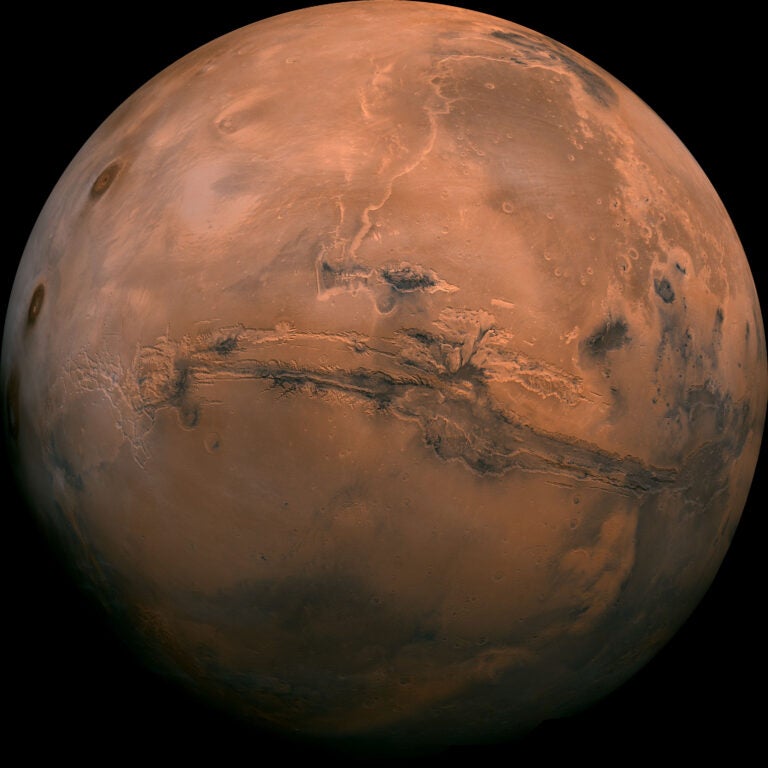Mars will pass 1.7° south of Neptune at 8 A.M. EDT, while the Moon will pass 4° south of Neptune at 7 P.M. EDT. Our satellite then passes 3° south of Mars at 8 P.M. EDT.
Look south after dark tonight to see Scorpius the Scorpion crawling his way into the sky. By 11 P.M. local time, his entire body and tail should be above the horizon for observers around 40° north latitude. Most obvious will be Antares, the Scorpion’s bright red heart. But follow the hook of his curving tail and you’ll find two open star clusters — M6 and M7 — to enhance the view.
With no Moon in the sky yet, the next few hours are the ideal time to explore these star cities. Although they can be visible to the naked eye under dark-sky conditions, they’re still relatively low to the horizon early in the evening and might be best spotted with binoculars. To find them, place the Scorpion’s stinger on the southern edge of your binoculars’ field of view and look north (upper left). Both clusters should appear in the same field of view.
M6, also classified as NGC 6405 and called the Butterfly Cluster, is the smaller of the two. Despite its name, to many observers it appears rectangular at first glance, rather than butterfly-shaped. But if you take some time to study the cluster’s stars, you may be able to make out the outline of the insect for which the cluster is named, flying toward the northwest.
Southeast of M6 is the larger, brighter M7 (NGC 6475), also called Ptolemy’s Cluster. Its larger size is due in part to its closer proximity to Earth — M7 is about 980 light-years away, while M6 is 1,590 light-years distant. M7 is also physically larger, covering 23 light-years, versus M6’s 10. Both clusters contain roughly the same number of stars.

Astronomy is pleased to present The Complete Star Atlas, the perfect resource for stargazers of all ages. This practical guide to viewing the night sky is now available, and includes approximately 87,000 stars, 1,200 deep-sky objects, and 24 high-quality star maps. You’ll also find 50 pages of astronomy history, tips, and more from experienced Contributing Editor Michael E. Bakich.
Last Quarter Moon occurs at 2:24 A.M. EDT this morning.
The window for spotting Mercury in the evening this month is quickly shrinking. The planet, currently magnitude 1.4, shows a 19-percent-illuminated crescent just 10″ across. It’s located about 11° below the bright star Pollux in Gemini the Twins, which you can spot in the west-northwest at sunset. An hour later, Mercury has disappeared below the horizon.
This trend will continue — the planet will dim to magnitude 2 and sit just 3° high 45 minutes after sunset by June 16.
Sunday, June 14
Jupiter’s moon Callisto is eclipsed by the planet’s shadow beginning at 1:17 A.M. EDT. In the moments leading up to the event, you can spot Callisto almost 1′ west of Jupiter. The moon slowly fades over the course of 10 minutes.
At the same time, innermost moon Io is approaching from the east. Its small shadow slides onto the planet at 1:25 A.M. EDT and begins to cross. Io follows at 2:07 A.M. EDT, tracking behind its shadow across the planet for the next two hours. Callisto will reappear at 5:09 A.M. EDT; East Coast observers may have difficulty spotting it against the brightening sky, but those farther west will likely have an easier time seeing the moon pop back into view.
The Moon reaches apogee at 8:57 P.M. EDT, when it will sit 251,404 miles (404,596 kilometers) from Earth.
Monday, June 15
Return to Jupiter for more Galilean moon action this morning, as Ganymede is eclipsed by the planet starting at 12:40 A.M. EDT. At the same time, Europa and its shadow are transiting the disk of the planet. Less than an hour later, at 1:36 A.M. EDT, Io pops into view from behind Jupiter, appearing on its eastern limb. Twenty minutes later, Europa’s shadow slips off the disk. The icy moon follows a little less than an hour and a half later, leaving the face of the planet at 3:18 A.M. EDT.
Just in case you want one more added bonus, wait an hour and the Great Red Spot will take center stage. The massive storm should appear roughly centered on the planet’s southern hemisphere around 4:43 A.M. EDT.
Uranus stands about 10° high in the east at 4:30 A.M. local time. The magnitude 5.9 planet has a disk just 3″ across and hangs 10° left of the Moon. This morning, our satellite is a beautiful 22-percent-lit crescent in the northeastern portion of the constellation Pisces. Nearby bright stars include magnitude 2 Hamal in Aries and magnitude 2.5 Menkar in Cetus. Uranus appears roughly halfway on a line between these two bright stars. Farther east is the famous Pleiades, whose dipper shape should still be relatively easy to find in the brightening sky. Later tonight, the Moon will pass 4° south of Uranus at 10 P.M. EDT.
For those who prefer evening observing, Comet PanSTARRS (C/2017 T2) is less than 1° from the barred spiral galaxy M109 (NGC 3992) tonight. Located in Ursa Major near the cup of the Big Dipper, both are visible all night from the northern U.S. All observers will want to catch the pair earlier rather than later, however, when the Great Bear is higher in the sky. The comet and its extragalactic companion are near Phecda (Gamma [γ] Ursae Majoris), the star that marks the lower left corner of the Dipper’s cup. Look 40″ east of the star to find M109, then about 40″ southwest of the galaxy to find the roughly magnitude 9 comet.
Wednesday, June 17
Mercury is stationary at 4 P.M. EDT. The tiny planet is 10° high around sunset and disappears below the horizon within an hour.
Whether you’re able to spot Mercury or not, you might see something else: noctilucent, or “night-glowing,” clouds. Common during warmer seasons, these clouds occur when ice crystals form on high-altitude dust particles 40 to 50 miles (64 to 80 km) above the ground. These pearly white clouds appear to glow even as other, lower clouds — which form more than 10 times lower — darken as night falls. These clouds are not unique to Earth, either — the Mars Curiosity rover has imaged noctilucent clouds drifting through the Red Planet’s skies.
Thursday, June 18
Venus now appears in the morning sky after its June 3 inferior conjunction. This morning, the magnitude –4.3 planet is 4° high 45 minutes before sunrise. It hangs 11° east of a 27-day-old crescent Moon. Through binoculars or a telescope, you’ll be able to see that its 52″-wide disk is a mere 7 percent lit. Tomorrow morning, the Moon will pass in front of, or occult, Venus from some parts of the world. Whether you can view the event or not, you will find the Moon much closer to our sister planet, so make sure to come back in 24 hours to see how the scene has changed.
Less than 10° above the planet in the sky is the sparkling Pleiades. Due north of this open cluster is the constellation Perseus the Hero. His beta star is magnitude 2.1 Algol. Sometimes called “the demon star,” Algol represents the gorgon Medusa’s severed head, held by Perseus, in depictions of the constellation’s figure. The star is actually an eclipsing binary system, tilted edge-on with respect to Earth. Every 2.867 days, the main star’s smaller, dimmer companion passes in front of it, causing Algol to appear to drop to magnitude 3.4 — just 30 percent its original brightness. The star appears to recover its glow within hours.
The Moon occults Venus for some regions of the world, including northwestern Europe and northern and eastern Canada. For U.S. observers, catching the planet at the moment it reappears from behind our satellite is challenging due to its low altitude. It’s also only possible for those in the northeastern U.S. From Massachusetts, the Moon rises at 3:55 A.M. EDT; it is a mere 1° high at 4:07 A.M., when the planet begins to reappear. Venus is 8 percent lit, while the Moon is just 4 percent illuminated.
Farther west, the pair will rise after the occultation has ended; the gap between them increases with time (and longitude). They still make a stunning spectacle and are worth observing as sunrise approaches; by 5 A.M. EDT, the Moon will be just 0.7° north of Venus.

Our exclusive Sky Guide 2020 is now available! This free downloadable pamphlet contains a month-by-month rundown of 2020’s biggest celestial events, from Mars’ best opposition in years to the return of totality in South America this December. Check out Astronomy’s Sky Guide 2020 now!

